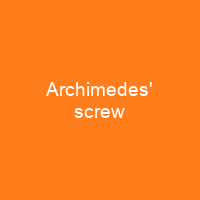Archimedes’ screw is a machine used for transferring water from a body of water into irrigation ditches. Water is pumped by turning a screw-shaped surface inside a pipe. Some researchers have postulated this as being the device used to irrigate the Hanging Gardens of Babylon, one of the Seven Wonders of the Ancient World.
About Archimedes’ screw in brief

This technology is primarily used at fish hatcheries where it is desirable to minimize the physical handling of fish. An axial pump is essentially an elevator or snow blower or grain elevator. It is basically an Archimede screw basically contain an archimedes flow pump basically contain a flow pump. It’s the oldest positive displacement pump. The first records of a water screw, or screw pump, date back to Hellenistic Egypt before the 3rd century BC. The Egyptian screw, used to lift water from the Nile, was composed of tubes wound round a cylinder; as the entire unit rotates, water is lifted within the spiral tube to higher elevation.
You want to know more about Archimedes’ screw?
This page is based on the article Archimedes’ screw published in Wikipedia (as of Dec. 10, 2020) and was automatically summarized using artificial intelligence.







